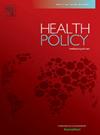Gender differences in healthcare utilization across Europe: Evidence from the European Health Interview Survey
IF 3.4
3区 医学
Q1 HEALTH CARE SCIENCES & SERVICES
引用次数: 0
Abstract
Background
Understanding gender-based disparities in healthcare utilization is crucial for informing equitable health policy. However, cross-national evidence across multiple service domains in Europe remains limited.
Objective
To examine gender differences in healthcare utilization across 27 European countries and explore variability across service types.
Methods
We analyzed data from 257,388 adults in the third wave of the European Health Interview Survey (2019–2020). Twelve healthcare utilization indicators were evaluated, including hospital admissions, outpatient care, mental health services, and medication use. Gender disparities were estimated using regression models with inverse probability weighting based on random forest propensity scores.
Results
Women had significantly higher odds of using nearly all outpatient and preventive services, including general practitioners, specialists, dental care, physiotherapy, psychotherapy, and home care. They also reported higher use of both prescribed and non-prescribed medications. No significant gender differences were observed in hospitalization rates. Sensitivity analyses adjusting for health needs confirmed these findings. Considerable heterogeneity emerged across countries and service domains: Latvia, Lithuania, and Poland showed the largest disparities (e.g., ORs 1.52–1.75 for recent specialist visits), while Denmark, the Netherlands, and Ireland displayed relatively small overall gaps but large differences for specific services, such as psychotherapy and home care.
Conclusions
Women consistently utilize more non-acute healthcare services than men, while comparable hospitalization rates suggest differences in disease severity or care-seeking behaviors. The magnitude of these disparities varies considerably across European countries, highlighting the need for context-sensitive policies to address gender inequities in healthcare utilization.
欧洲各地医疗保健利用的性别差异:来自欧洲健康访谈调查的证据。
背景:了解基于性别的医疗保健利用差异对于告知公平的卫生政策至关重要。然而,在欧洲,跨多个服务领域的跨国证据仍然有限。目的:研究27个欧洲国家医疗保健利用的性别差异,并探讨不同服务类型的可变性。方法:我们分析了第三轮欧洲健康访谈调查(2019-2020)中257388名成年人的数据。评估了12项医疗保健利用指标,包括住院率、门诊护理、精神卫生服务和药物使用。使用基于随机森林倾向得分的逆概率加权回归模型估计性别差异。结果:妇女使用几乎所有门诊和预防服务的几率明显更高,包括全科医生、专科医生、牙科护理、物理治疗、心理治疗和家庭护理。他们还报告说,处方药和非处方药的使用率都较高。在住院率方面没有观察到显著的性别差异。根据健康需求调整的敏感性分析证实了这些发现。不同国家和服务领域出现了相当大的异质性:拉脱维亚、立陶宛和波兰的差异最大(例如,最近的专家访问的or为1.52-1.75),而丹麦、荷兰和爱尔兰的总体差距相对较小,但在心理治疗和家庭护理等特定服务方面存在较大差异。结论:女性一直比男性使用更多的非急性医疗保健服务,而可比较的住院率表明疾病严重程度或求医行为的差异。这些差异的程度在欧洲各国之间差别很大,突出表明需要根据具体情况制定政策,以解决医疗保健利用中的性别不平等问题。
本文章由计算机程序翻译,如有差异,请以英文原文为准。
求助全文
约1分钟内获得全文
求助全文
来源期刊

Health Policy
医学-卫生保健
CiteScore
6.40
自引率
6.10%
发文量
157
审稿时长
3-8 weeks
期刊介绍:
Health Policy is intended to be a vehicle for the exploration and discussion of health policy and health system issues and is aimed in particular at enhancing communication between health policy and system researchers, legislators, decision-makers and professionals concerned with developing, implementing, and analysing health policy, health systems and health care reforms, primarily in high-income countries outside the U.S.A.
 求助内容:
求助内容: 应助结果提醒方式:
应助结果提醒方式:


